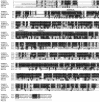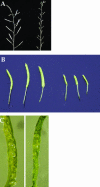An ATP-binding cassette transporter GhWBC1 from elongating cotton fibers
- PMID: 12972649
- PMCID: PMC219034
- DOI: 10.1104/pp.103.027052
An ATP-binding cassette transporter GhWBC1 from elongating cotton fibers
Abstract
We have isolated a cDNA (GhWBC1) from cotton (Gossypium hirsutum) that encodes an ATP-binding cassette transporter of the WBC (white/brown complex) subfamily. Members of this subfamily are half-sized transporters and are reported to mediate lipid and drug excretion in human (Homo sapiens). GhWBC1 is highly expressed in developing fiber cells, but transcripts were also detectable in other tissues except roots. The transcript level peaked in rapidly expanding fibers from 5 to 9 DPA and then decreased. The GhWBC1 expression was weak in fiber cells of an li (ligon-lintless) mutant, which is defective in fiber cell elongation. These data indicate that GhWBC1 gene expression correlates with cotton fiber elongation. Transient expression of enhanced green fluorescence protein-GhWBC1 fusion protein in onion (Allium cepa) epidermal cells revealed plasma membrane localization. The GhWBC1 cDNA driven by a constitutive 35S promoter was introduced into Arabidopsis. About 13% of the transformants produced short siliques (SSs), whereas others had normal siliques (long siliques [LSs]). In siliques of SS lines, most embryos were severely shriveled, and only several seeds per silique could be found at maturity. The transgene expression level was higher in SS lines than in LS lines. Expression of AtWBC11, the closest homolog of GhWBC1 in Arabidopsis, was not altered in either SS or LS transgenic plants examined. These data suggest that GhWBC1 interferes with substance translocation that is required for Arabidopsis seed and silique development. Characterization of Arabidopsis WBC members, particularly AtWBC11, will help to dissect the role of GhWBC1 in cotton fiber development and elongation.
Figures








Similar articles
-
Gene expression profile analysis of Ligon lintless-1 (Li1) mutant reveals important genes and pathways in cotton leaf and fiber development.Gene. 2014 Feb 10;535(2):273-85. doi: 10.1016/j.gene.2013.11.017. Epub 2013 Nov 23. Gene. 2014. PMID: 24279997
-
Activation of Arabidopsis seed hair development by cotton fiber-related genes.PLoS One. 2011;6(7):e21301. doi: 10.1371/journal.pone.0021301. Epub 2011 Jul 11. PLoS One. 2011. PMID: 21779324 Free PMC article.
-
A MADS-box gene is specifically expressed in fibers of cotton (Gossypium hirsutum) and influences plant growth of transgenic Arabidopsis in a GA-dependent manner.Plant Physiol Biochem. 2014 Feb;75:70-9. doi: 10.1016/j.plaphy.2013.12.003. Epub 2013 Dec 17. Plant Physiol Biochem. 2014. PMID: 24374505
-
Cotton AnnGh3 encoding an annexin protein is preferentially expressed in fibers and promotes initiation and elongation of leaf trichomes in transgenic Arabidopsis.J Integr Plant Biol. 2013 Oct;55(10):902-16. doi: 10.1111/jipb.12063. Epub 2013 Jul 29. J Integr Plant Biol. 2013. PMID: 23651035
-
Integrated metabolomics and genomics analysis provides new insights into the fiber elongation process in Ligon lintless-2 mutant cotton (Gossypium hirsutum L.).BMC Genomics. 2013 Mar 7;14:155. doi: 10.1186/1471-2164-14-155. BMC Genomics. 2013. PMID: 23497242 Free PMC article.
Cited by
-
Genome-wide association study of fiber yield-related traits uncovers the novel genomic regions and candidate genes in Indian upland cotton (Gossypium hirsutum L.).Front Plant Sci. 2023 Oct 23;14:1252746. doi: 10.3389/fpls.2023.1252746. eCollection 2023. Front Plant Sci. 2023. PMID: 37941674 Free PMC article.
-
Gene expression changes and early events in cotton fibre development.Ann Bot. 2007 Dec;100(7):1391-401. doi: 10.1093/aob/mcm232. Epub 2007 Sep 27. Ann Bot. 2007. PMID: 17905721 Free PMC article. Review.
-
Transcriptome and metabolome profiling provide insights into molecular mechanism of pseudostem elongation in banana.BMC Plant Biol. 2021 Mar 1;21(1):125. doi: 10.1186/s12870-021-02899-6. BMC Plant Biol. 2021. PMID: 33648452 Free PMC article.
-
ABCG1 contributes to suberin formation in Arabidopsis thaliana roots.Sci Rep. 2019 Aug 6;9(1):11381. doi: 10.1038/s41598-019-47916-9. Sci Rep. 2019. PMID: 31388073 Free PMC article.
-
The Basic/Helix-Loop-Helix Protein Family in Gossypium: Reference Genes and Their Evolution during Tetraploidization.PLoS One. 2015 May 18;10(5):e0126558. doi: 10.1371/journal.pone.0126558. eCollection 2015. PLoS One. 2015. PMID: 25992947 Free PMC article.
References
-
- Applequist WL, Cronn R, Wendel JF (2001) Comparative development of fiber in wild and cultivated cotton. Evol Dev 3: 3–17 - PubMed
-
- Basra AS, Malik CP (1984) Development of cotton fiber. Int Rev Cytol 89: 65–113
-
- Berge K, Tian H, Graf GA, Yu L, Grishin NV, Schultze J, Kwiterovich P, Shan B, Barnes R, Hobbs HH (2000) Accumulation of dietary cholesterol in sitosterolemia caused by mutations in adjacent ABC transporters. Science 290: 1771–1775 - PubMed
-
- Bissinger PH, Kuchler K (1994) Molecular cloning and expression of the Saccharomyces cerevisiae STS1 gene product: a yeast ABC transporter conferring mycotoxin resistance. J Biol Chem 269: 4180–4186 - PubMed
Publication types
MeSH terms
Substances
LinkOut - more resources
Full Text Sources
Other Literature Sources
Molecular Biology Databases

